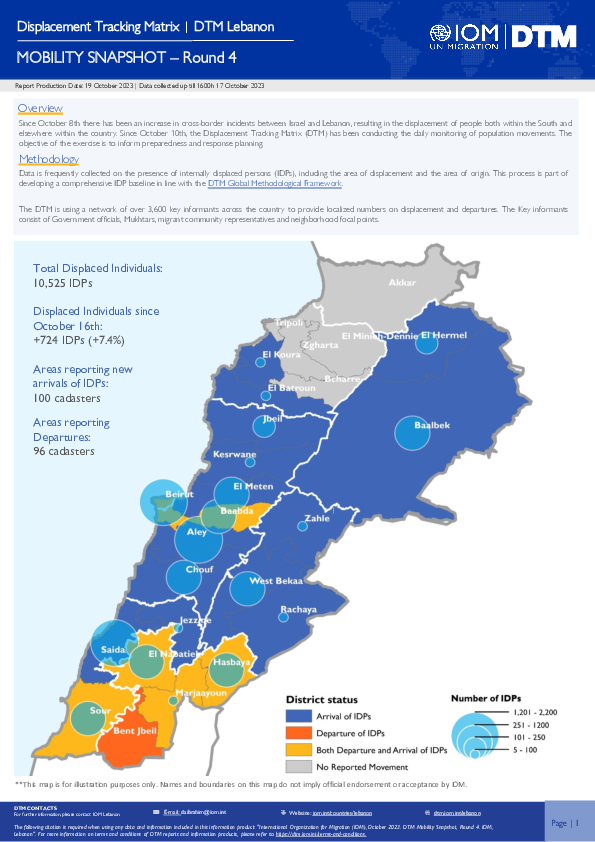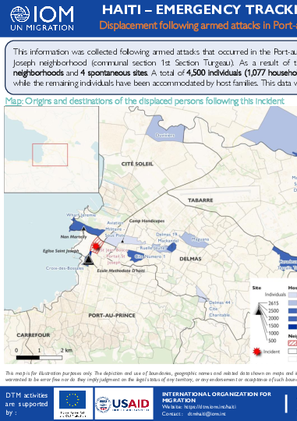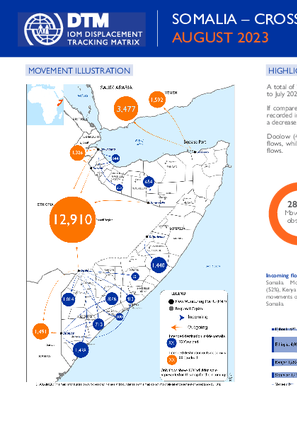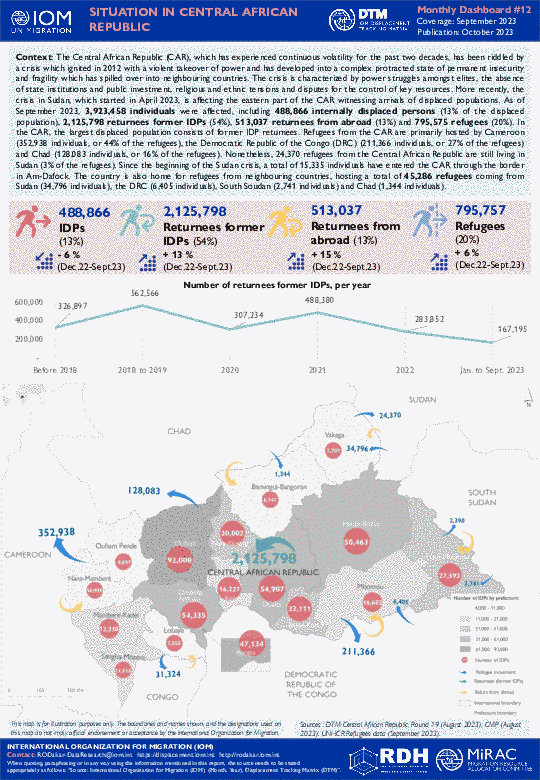-
Countries
-
Data and Analysis
-
Special Focus
-
Crisis Responses
The crisis currently affecting the Lake Chad Basin states results from a complex combination of factors, including conflict with non-state armed groups, extreme poverty, underdevelopment and a changing climate, which together have triggered significant displacement of populations. As of September 2023, Cameroon, Chad, Niger and Nigeria were hosting an estimated 5,949,994 affected individuals made up of internally displaced persons (IDPs), returnees (former IDPs and returnees from abroad) and refugees (both in- and out-of-camp).
The Central African Republic (CAR), which has experienced continuous volatility for the past two decades, has been riddled by a crisis which ignited in 2012 with a violent takeover of power and has developed into a complex protracted state of permanent insecurity and fragility which has spilled over into neighbouring countries. The crisis is characterized by power struggles amongst elites, the absence of state institutions and public investment, religious and ethnic tensions and disputes for the control of key resources. More recently, the crisis in Sudan, which started in April 2023, is affecting the eastern part of the CAR witnessing arrivals of displaced populations. As of September 2023, 3,923,458 individuals were affected, including 488,866 internally displaced persons (13% of the displaced population), 2,125,798 returnees former IDPs (54%), 513,037 returnees from abroad (13%) and 795,575 refugees (20%). In the CAR, the largest displaced population consists of former IDP returnees. Refugees from the CAR are primarily hosted by Cameroon (352,938 individuals, or 44% of the refugees), the Democratic Republic of the Congo (DRC) (211,366 individuals, or 27% of the refugees) and Chad (128,083 individuals, or 16% of the refugees). Nonetheless, 24,370 refugees from the Central African Republic are still living in Sudan (3% of the refugees). Since the beginning of the Sudan crisis, a total of 15,335 individuals have entered the CAR through the border in Am-Dafock. The country is also home for refugees from neighbouring countries, hosting a total of 45,286 refugees coming from Sudan (34,796 individuals), the DRC (6,405 individuals), South Soudan (2,741 individuals) and Chad (1,344 individuals).

Contact
daibrahim@iom.int
Language
English
Location
Lebanon
Period Covered
Oct 10 2023
Oct 17 2023
Activity
- Mobility Tracking
- Baseline Assessment
Since October 8 there has been an increase in cross-border incidents between Israel and Lebanon, resulting in the displacement of people both within the South and elsewhere within the country. Since October 10, the Displacement Tracking Matrix (DTM) has been conducting the daily monitoring of population movements. The objective of the exercise is to inform preparedness and response planning.

Contact
dtmhaiti@iom.int
Language
English
Location
Haiti
Period Covered
Oct 13 2023
Oct 17 2023
Activity
- Mobility Tracking
- Event Tracking
This information was collected following armed attacks that occurred in the Port-au-Prince municipality since 13 October 2023, specifically in the St Jean Bosco - Portail St Joseph neighborhood (communal section 1st Section Turgeau). As a result of these attacks, residents from this neighborhood were forced to flee to 12 different neighborhoods and 4 spontaneous sites. A total of 4,500 individuals (1,077 households) have been displaced. Among them, 3,594 persons (80%) have sought refuge in sites, while the remaining individuals have been accommodated by host families. This data was collected from key informants through telephone interviews.

Contact
DTM Europe, DTMMediterranean@iom.int
Language
English
Location
Slovakia
Period Covered
Apr 01 2023
Jun 30 2023
Activity
- Survey
- Return Intention
This report is based on a survey of displacement patterns, needs and intentions conducted by IOM's Displacement Tracking Matrix (DTM) in 11 countries included in the Regional Response Plan for Ukraine in 2023: 6 countries neighbouring Ukraine — Belarus, Hungary, Poland, Republic of Moldova, Romania and Slovakia — and 5 other countries particularly impacted by the arrivals of refugees from Ukraine since the start of the war in February 2022 — Bulgaria, Czechia, Latvia and Lithuania.
Slovakia — Key Findings:
- Top oblasts of origin: Kharkivska (16%), Zakarpatska (14%), Donetska oblast (11%) and Kyiv city (12%)
- Intention to move: 79% have no intention to move, 5% want to move to a different country (Top 3 destinations were: Germany, Ireland, Canada), 5% would like to return to their region of origin in Ukraine.
- Education level: 53% completed tertiary, 3% post-secondary and 33% upper secondary education.
- Employment status: 32% employed and 29% unemployed respondents (6% of the unemployed were not looking for a job). The rest were retired, students, or persons on maternity or paternity leave.
- Immediate needs: Health services (50%), financial support (48%), medicine (45%), language courses (34%), education for adults (31%).*
- Inclusion challenges: Financial issues (45%), language barriers (26%), access to services (26%).*
*Multiple answers possible.

Contact
DTM Pakistan, iomisbdtmremapteam@iom.int
Language
English
Location
Pakistan
Period Covered
Oct 01 2023
Oct 15 2023
Activity
- Flow Monitoring
Between 01 and 15 October 2023, 37,317 Afghan nationals spontaneously returned to Afghanistan, including 26,896 through the Torkham border point and 10,421 through the Chaman border point. In addition, border authorities forcibly returned 614 individuals due to a lack of valid documentation. Cumulatively, since 1 January 2023, IOM identified 121,977 Afghan returnees at the two border crossings, excluding those forcibly returned.
On 26 September 2023, the Ministry of Interior (MoI) in Pakistan announced its decision to enact an “Illegal Foreigners’ Repatriation Plan”. The plan comprises of mechanisms to consolidate databases of “illegal foreigners” in the country, check entry of new illegal entrants, apprehension, deportation, repatriation of illegal/ overstaying foreigners.
Contact
DTMDRC@iom.int
Location
Democratic Republic of the Congo
Activity
- Mobility Tracking
- Baseline Assessment
Period Covered
-Aug 06 2023
A baseline assessment is a sub-component of mobility tracking. It aims to collect data on IDP, migrant or returnee population presence in a defined administrative area of the country.
Population Groups
Survey Methodology
Unit of Analysis Or Observation
Type of Survey or Assessment
Keywords
Geographical Scope
Administrative boundaries with available data
The current dataset covers the following administrative boundaries

Contact
DTM Somalia, IOMSomaliaDTM@iom.int
Language
English
Location
Somalia
Period Covered
Sep 01 2023
Sep 30 2023
Activity
- Flow Monitoring Survey
- Flow Monitoring
A total of 24,816 movements were observed in September 2023, representing 13 per cent decrease compared to August 2023 when 28,643 movements were observed during this period. If compared with August 2023 Bossaso (1%) FMP recorded increase in movements while Harirad (-23%), Cabudwaaq (-19%), Doolow (-18%), Dhobley (-14%), Lowyacado (-8%) and Buuhoodle (-0.4%) FMPs recorded a decrease in movements. Doolow (40%), Dhobley (25%) and Cabudwaaq (19%) FMPs recorded the highest numbers of incoming flows, while Doolow (55%), Bossaso (28%) and Dhobley (7%) recorded the highest numbers of outgoing flows.

Contact
DTM Somalia, IOMSomaliaDTM@iom.int
Language
English
Location
Somalia
Period Covered
Aug 01 2023
Aug 31 2023
Activity
- Flow Monitoring
A total of 28,643 movements were observed in August 2023, representing 17 per cent increase compared to July 2023 when 24,583 movements were observed during this period. If compared with July 2023 Doolow (29%), Bossaso (21%), Dhobley (6%) and Cabuudwaaq (0.1%) FMPs recorded increase in movements while Buuhoodle (-28), Lowyacado (-3%) and Harirad (-2%) FMPs recorded a decrease in movements. Doolow (41%), Dhobley (24%) and Cabudwaaq (18%) FMPs recorded the highest numbers of incoming flows, while Doolow (59%), Bossaso (24%) and Dhobley (7%) recorded the highest numbers of outgoing flows.
Contact
DTM Sudan, DTMSudan@iom.int
Location
Sudan
Activity
- Mobility Tracking
- Baseline Assessment
Period Covered
Apr 15 2023 -Oct 13 2023
Overview
From 15 April 2023, armed clashes erupted between the Sudanese Armed Forces (SAF) and the Rapid Support Forces (RSF). Clashes initially took place in cities across Northern and Khartoum states, later spreading across the Darfur and Kordofan regions.
Key Findings
DTM Sudan estimates that 4,570,541 Individuals (911,531 Households) have been recently internally displaced.
The IDP caseload has been observed in 4,658 locations across all of Sudan’s 18 states.
The highest proportions of IDPs have been observed in River Nile (12.62%), South Darfur (11.23%), East Darfur (10.97%), Aj Jazirah (8.03%), Northern (7.92%), and North Darfur (7.37%).
Field teams report that the IDPs observed were originally displaced from eight states. The majority (3,127,888 IDPs, 68.44%) have been reportedly displaced from Khartoum state; followed by South Darfur (14.63%), North Darfur (7.94%), Central Darfur (4.01%), West Darfur (3.75%), South Kordofan (0.76%), North Kordofan (0.46%), and Aj Jazirah (0.01%).
IOM DTM also reports that an estimated 1,256,436 mixed cross-border movements have been made into neighbouring countries.
A more detailed version of this dataset is available, to get access kindly click on the "Request Access" button.
Population Groups
Survey Methodology
Unit of Analysis Or Observation
Type of Survey or Assessment
Keywords
Geographical Scope
Administrative boundaries with available data
The current dataset covers the following administrative boundaries


